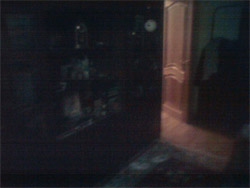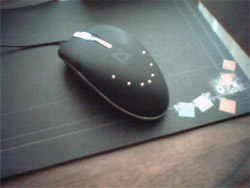Review Pocket PC clamshell Rover S2
Package:
- Smartphone
- Synchronization cable
- Charger
- Stereo headset
- CD with software
- Manual
- Bluetooth headset (optional)

Several months ago we wrote that Rover had left the PDA market. At that moment the company didn't make any official announcements. After our publication the topic had been much discussed in electronic periodicals and at specialized forums. Soon afterwards in an interview to the newspaper "Vedomosti" the president of Rover Computers Sergey Shuniaev said, "We do not release PDAs any longer, only smartphones. The current demand for PDAs is limited, besides a tough price competition reigns on the market. And the sales of smartphones are good". The matter seemed to be settled, but the story got continued. Several days after the publication of the interview Andrei Andreev, the marketing director of Rover Computers said in the interview to www.cnews.ru that "Rover Computers will keep on releasing handheld computers". Several times we tried to get official comments on the situation, but there was none. Somehow or other the company is now selling Rover S2, the rest models under the Rover brand are gradually disappearing from shops.

Rover S2 is the second smartphone under the Rover brand. Its predecessor Rover S1 had good sales due to a well-balanced price/quality ratio. S1 is produced by the Taiwanese company Wistron. In summer 2004 Wistron left the PDA market, as it lost its main customer Dell, for which Wistron produced Dell Axim X5 (now new Axim models are made at the HTC plants). Rover S2 (or the Lenovo ET560, the model distributed on the Chinese market from the early 2004) is produced by a Chinese company Legend Group.
The S2 looks unusual for Pocket PC featuring a clamshell form-factor and a rotating screen. If we look at the photos, the device seems to be an ordinary phone in a clamshell form. But when you see it alive, this illusion fades away. The smartphone shocks and amazes people around as it resembles a phone of increased size (107x63.x24.7 mm).

However if to compare S2 (closed up and the screen outside) with other Pocket PC representatives, then the size turns to be quite acceptable. Although many people subconsciously compare this smartphone with a clamshell-phone first of all.

The manufacturers of the model had to minimize the screen diagonal from the standard 3.5" to 2.9" (3" are claimed, however some simple measurements reveal that the active zone features 45x60 mm, i.e. the diagonal is 2.92" long). Should the diagonal be a standard one, the size of this Pocket PC clamshell when open would be very uncomfortable, so the smaller screen is the step in the right direction. At the same time Pocket PC smartphones are gradually switched from 3.5" to 2.8-3" (Asus p505, HTC Magician, Eten p300, Motorola MPx) exchanging comfort perception of info displayed on the screen for compact size. Let's get back to the screen of Rover S2. If not take into account the size other features are typical for Pocket PC - TFT 320x240 pixel resolution, 65K colors. It works well indoors, and outdoors the info is readable. The color rendering isn't good - all colors are pale, not rich as on HTC Magician (I-mate Jam) or Rover S1. At screen edges you can notice uneven backlight (color spots).

The casing is made of a classic silver plastic, when you touch it, you feel the plastic, it doesn't make an illusion of a metallic surface. It's possible to open the smartphone with one hand, however that's not comfortable, as you have to catch the smartphone. In both positions the screen is fixed, you hear a distinct, but not loud click. In the intermediate positions the screen is loose and falls down to one of the extremes.

The screen can be rotated in one direction. You can rotate and fold the screen, so it looks like a classical Pocket PC, but somewhat thick. By the way it's possible to talk in two variants - when open and when closed (the screen is hidden). You can't use it as a phone when closed and the screen is outside. The joint that binds two halves of the smartphone feels secure.

The smartphone stands out for its form-factor and the integrated digital keyboard. Here arise some questions and confusions.
Firstly, there is enough space for a thumb QWERTY board like in Palm Treo 600, the device is wide enough for it. However there is a digital keyboard instead. On that large space 12 digital keys rest free, they are big and comfortable. The rest space is occupied with six application buttons (Contacts, Calendar, E-mail, Browser, Start and even a separate button for MMS!). The 5D-pad behaves well in applications, but in games it feels uncomfortable.
Secondly, the program implementation finds itself in the bud. In fact, you can only dial phone numbers from the digital keyboard after pressing the green Send button. There is no way to enter texts, you can't even enter PIN from this keyboard, it's impossible to use it for searching names from the address book. The potential, for which the classical Pocket PC format has been reshaped, wasn't implemented. Quarta, the company engaged in localization of the device on the Russian market, has partially improved the situation. It introduced two text input methods - Double Click and Multi Click. We are familiar with Multi Click, as it's the common way we enter texts on mobile phones not using T9 (for example, to enter "S" letter press "7" four times). Double Click represents an unusual method, you enter each symbol in the sequence of two keys. First press the button, to which the letter is assigned, and then the sequence number on that key. Well, to enter "S" (the fourth letter on the key "7") press "7" and then "4", to enter 'N" press "6" and then "2".

At the left side there are volume buttons, voice recorder button, SD/MMC slot (SDIO). You can use the slot with different peripherals. For example, a GPS-receiver or a Wi-Fi card. By standard means you can't assign other functions to volume buttons, only with the help of some exterior utility. A separate camera button rests at the right side, in my opinion its location isn't comfortable. The angle between two halves and the location of the camera make it difficult to use the camera, when the smartphone is open. Well, close it up and set the main screen out.

The external monochrome screen displays essential info (time, signal and battery level, network, unread messages and missed calls). Under the sunlight you see the screen info well, so the screen fulfils its function. On that surface you also find an extra dynamic and a microphone, so you can talk on the phone when it's closed up. The dynamic volume and the sensitivity of the microphone were high enough all the time. At the joint there are two standard Pocket PC indicators.

On the top you'll find the silo, 2.5 mm audio jack and a hardly noticeable infrared port. The metallic stylus is comfortable in use. As for the external antenna, it could have been hidden inside given the size of the device.
At the back panel you notice the camera, flash for it, battery cover and the soft reset button.
At the bottom there is the connector for charging and synchronization, which is protected with a rubber gag. The latter isn't attached to the casing, so it's highly possible to lose it sooner or later. The mini-USB port can be used not only for synchronization, but also for charging directly from PC.

Wireless
The handheld is dual band (GSM 900/1800), unlike a tri-band Rover S1. There is a support of GPRS Class 10. And you can use the smartphone as an external modem.
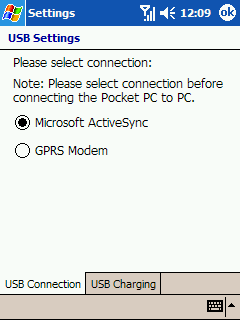
IrDA. The infrared port supports SIR standard (Slow Infrared), however it won't serve as a remote control for home electronics - the maximum active distance makes up 30 cm.
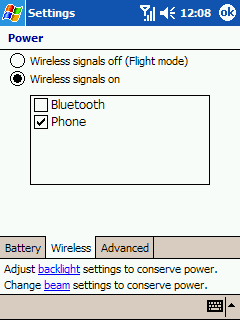
Bluetooth. One of the main weak points of Rover S1 was the lack of Bluetooth support. Rover S2 has it no longer. However I was upset with the implementation of Bluetooth - no standard WIDCOMM drivers, instead there are just drivers built in Windows Mobile 2003, they offer poor opportunities, the important part of profiles is either missing or badly implemented. But the main functions runs well - the communication with the Bluetooth-headset, synchronization and Internet access. The smartphone comes in two versions - with the Bluetooth-headset and without it, naturally they have different price. In my own experience, the headset attracts less attention than Rover S2 being unfolded.

Battery life
A removable battery is fixed firm, there is no backlashes. It's capacious of 1200 mAh. The manufacturer claimed 3-5 hours of talks and 100-130 hours standby. Our tests revealed that the smartphone was good for about 24 hours with intensive talks (30 minutes), 5-6 hours in the PDA mode. Rover S2 worked for 48 hours, we used it 2-3 hours a day. If you need to use it rarely (10 minutes - the whole time), the smartphone will work for some 72 hours. In all, it's an average result for this class of devices. An extended capacity battery (2400 mAh) is also available, however it'll add to size, weight and the time offline.
Camera
The talks about the camera will be very short. The quality of the integrated VGA-camera (the highest picture resolution - 640x480 points) proved average, lately such cameras have been built in every gadget without distinction. See the examples of the photos:
The camera can shoot video clips at a 160x120 pixel resolution.
Specifications
Rover S2 carries standard 64 MB of RAM onboard, 61.7 MB of which are available to a user. The XScale PXA260 400 MHz processor by Intel powers the handheld.
We used the SPB Benchmark package to test the performance. For this purpose we've chosen several similar models.
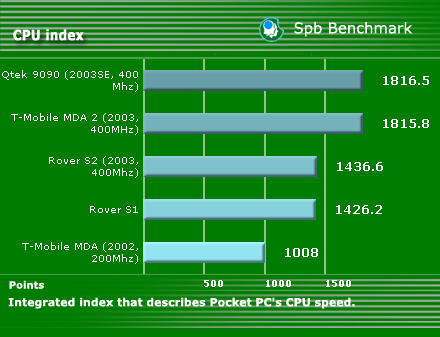
This index describes Pocket PC's CPU speed. Two models by HTC occupy leading positions, then Rover S2 and S1 follow with a little lag.
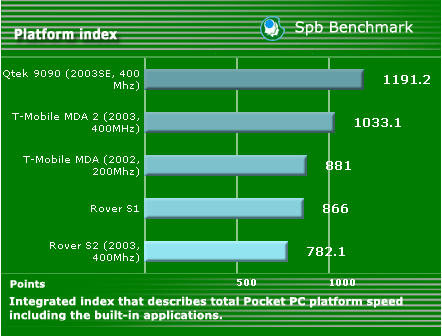
The platform index describes total Pocket PC platform speed including the built-in applications.
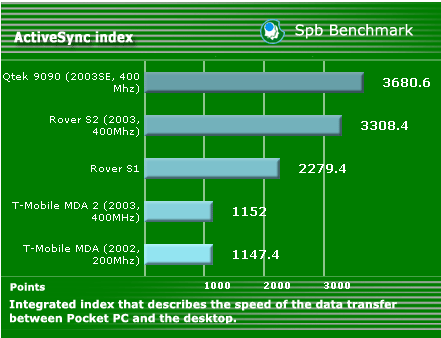
The synchronization speed is high.
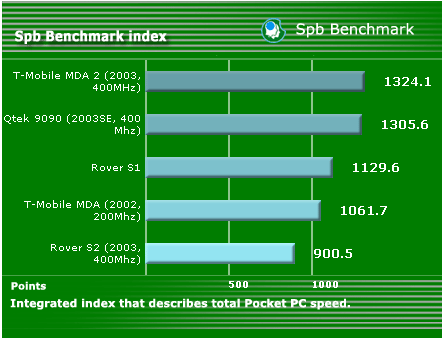
Integrated index describes total Pocket PC speed. Here Rover S2 had the lowest performance. However you'll hardly notice it with most Pocket PC applications, except for games and video playback.
To test graphics we ran tests of the PocketQuake game in the mute mode (turn the sound off by nosound 1 console command) leaving other settings unchanged. A little innovative move - we bring in Quake Index to make the results more clear. The index is calculated the following way: ((Demo_1_240x180)*1/6+(Demo_1_320x240)*1/3+(Demo_2_240x180)*1/6+(Demo_2_320x240)*1/3)*1000)/Quake_Index(FS Pocket LOOX 610).

This time Rover S2 loses even to Rover S1.
Video test. We launched several test clips at different intensity (kbps - kilobit per second, DivX 5.03 codec used). Sound got encoded in the mp3 format with 128 kbps bitrate. We applied the criteria of dropped frames while playing, the less the better and tested a fragment from the motion picture Cats and Dogs (the fight scene). Like in case with Pocket Quake we introduced Video Performance Index. Well, see the results:

Here again Rover S2 is beaten by all rivals.
Software
Initially the operating system Pocket PC (PPC 2002, WM 2003) isn't designed to manage phone functions (unlike special version for smartphones Windows Mobile 2003 for Smartphone). Rover S2 is powered by WM 2003 for Pocket PC Phone Edition, which is the very Windows Mobile 2003 for Pocket PC Premium Edition, but extended with several applications to manage phone functions.

AVI Player. The application to view video clips shot by the integrated camera.
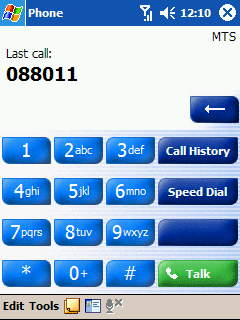
Phone.
Here you can find everything charged with making calls. This way the application looks in the standby mode, displaying the keyboard and the last call, which is dialed when you press the button on the headset (no matter whether it is in or out). Without some extra software the smartphone (to be more exact, the operating system) doesn't support the voice dial.
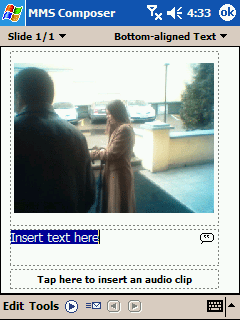
MMS Composer creates MMS messages.
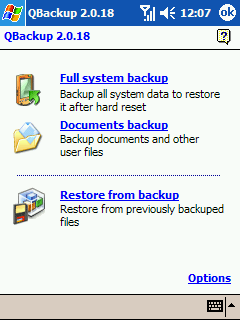
QBackup. The utility meant for the data backup.
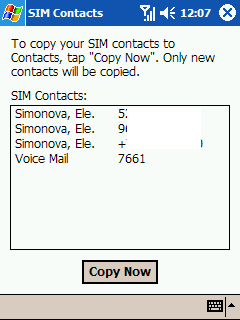
SIM Contacts works with contacts stored on the SIM-card and copies them into the phone memory.
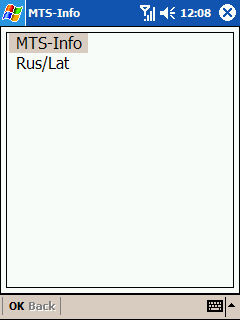
SIM-menu navigates SIM-menu.
All other applications are quite standard for WM2003 Phone Edition.
The smartphone is supplied fully russified (At the first launch you can choose between Russian and English languages).
Conclusion
The network reception quality proved to be good. The dynamic is loud enough, you can add any melody you want in WAV format. During the talk you hear your call-mate well. The power of the vibra call is average.
The raisin of the device is its appearance. Rover S2 is bulky for the phone even for men, not to mention women. The smartphone shocks and amazes people around, it looks like a hypertrophied clamshell. The fact that saves the day it that you can have a phone talk when the S2 is closed up or using a headset, not attracting somebody's attention. Instead of the digital keyboard there might be a thumb QWERTY board, however even from this digital one you can't enter a text as on the "common" mobile phone. The Russian company Quarta solved this problem by developing the dual text input system, else the existing keyboard might turn functionally invalid - only entering phone number and nothing else. Partially the dimensions got less due to the screen, however not only the diagonal was affected, but also the picture quality (pale colors, uneven backlight). The battery life is typical for the Pocket PC smartphone, and the double capacity battery represents a definite advantage. In the productivity tests Rover S2 has lost almost to every model, but that's crucial for the video playback and "resource-heavy" games. The existence of Bluetooth is good, but many profiles aren't implemented. The camera features an average quality.
As a result we get quite a queer device priced at $610-620 (current prices), the consumers might be lured by illusive comfort of the integrated keyboard and opportunities of a full value operating system. Another positive moment is the variant with the non-expensive Bluetooth-headset supplied for extra $60.
Description:
- Class: Pocket PC smartphone
- Position in the line: above Rover S1
- Operating system: Windows Mobile 2003 Phone Edition
- Processor : Intel XScale PXA260 400 MHz
- RAM: 64 MB
- Interface: SD/MMC slot, IrDA sir, Bluetooth 1.1
- GSM 900/1800, GPRS , TI chipset
- Screen: TFT 2.9", 240х320 pixels, 65K colors
- External screen - 1.2" monochrome STN, blue backlight
- Battery: removable Li-Ion 1200 mAh
- Dimensions: 107x63.5x24.7 - 25.7 mm
- Weight: 176 g.
We are grateful to PalmShop.ru for the provided devices.
Anton Kotov (anton.kotov@mobile-review.com)
Translated by Anja Rytchkova (anja.rytchkova@mobile-review.com)
Published - 22 November 2004
Have something to add?! Write us... eldar@mobile-review.com
|














